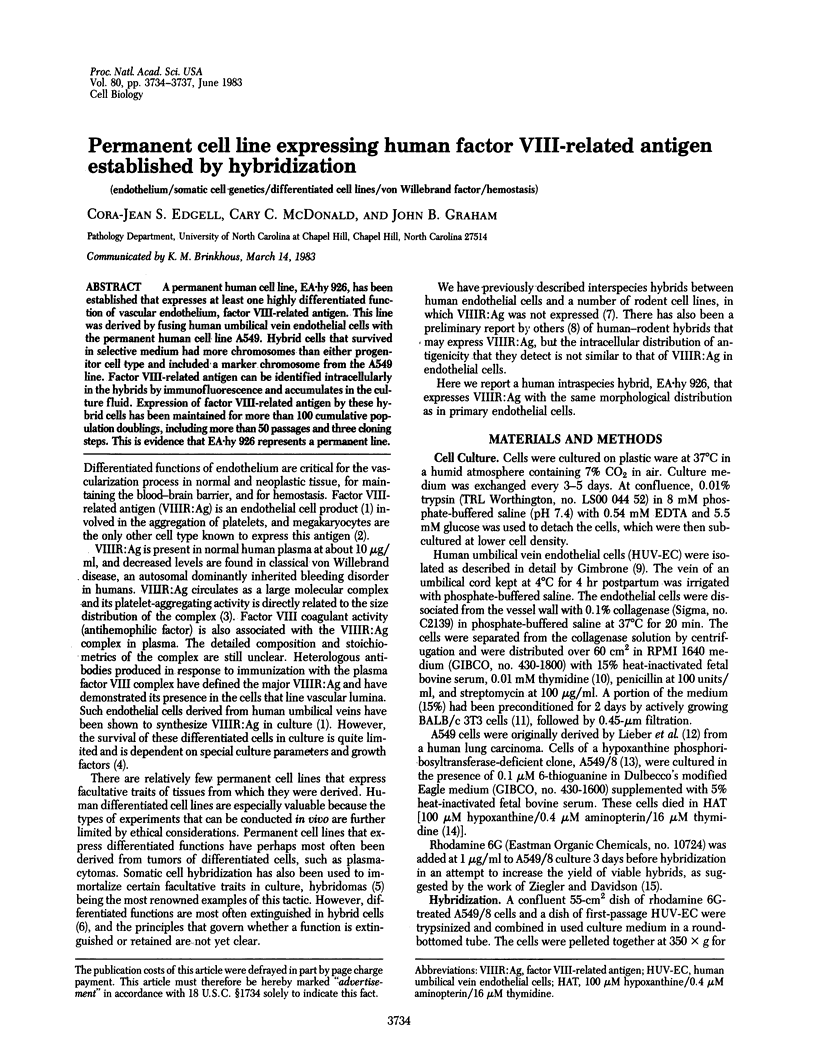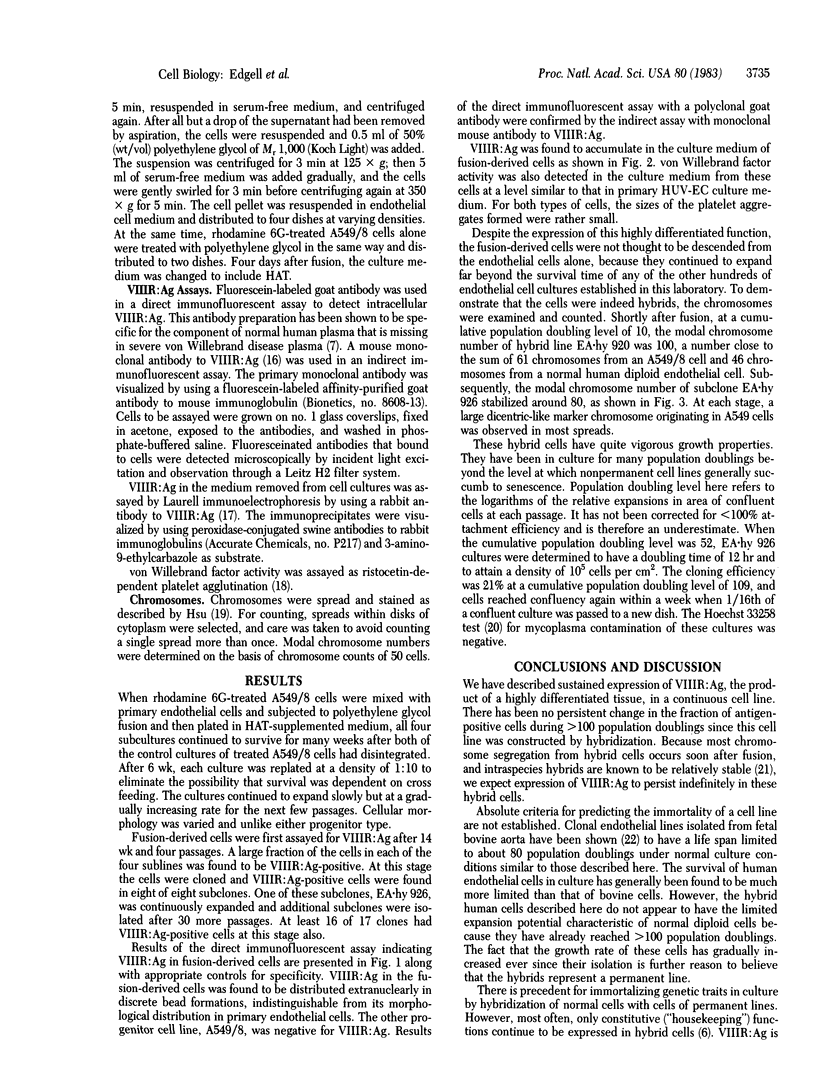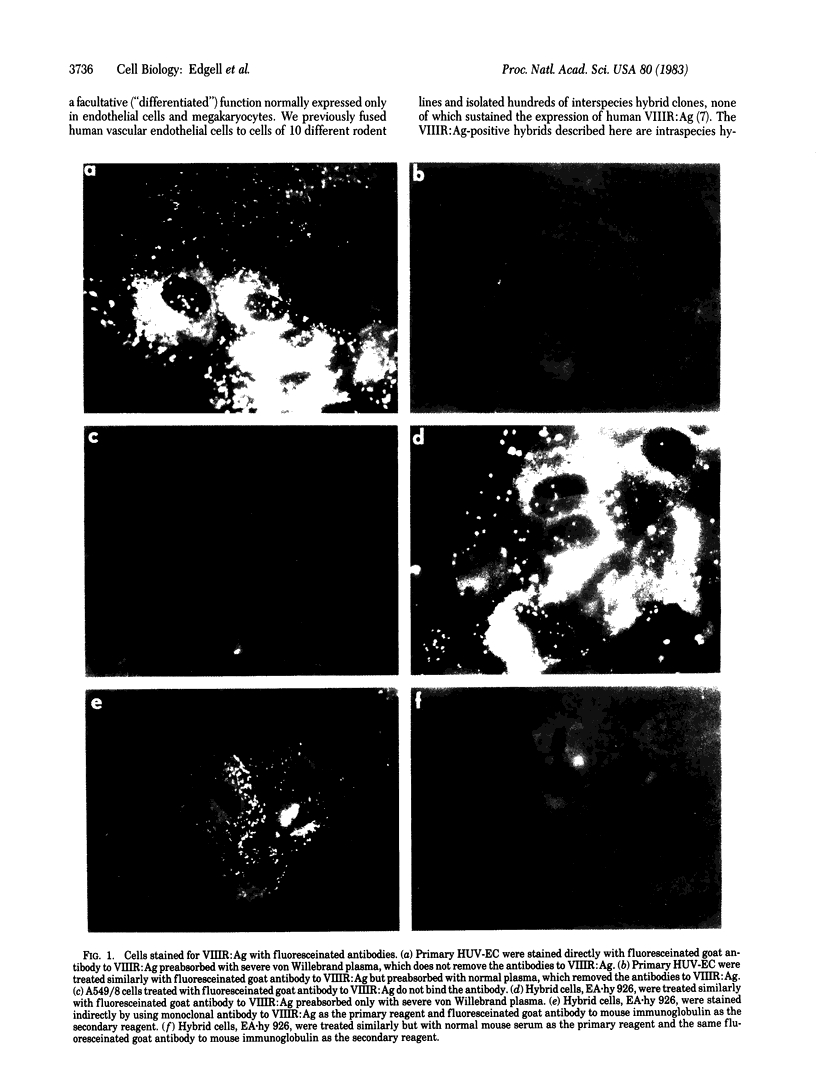Abstract
A permanent human cell line, EA . hy 926, has been established that expresses at least one highly differentiated function of vascular endothelium, factor VIII-related antigen. This line was derived by fusing human umbilical vein endothelial cells with the permanent human cell line A549. Hybrid cells that survived in selective medium had more chromosomes than either progenitor cell type and included a marker chromosome from the A549 line. Factor VIII-related antigen can be identified intracellularly in the hybrids by immunofluorescence and accumulates in the culture fluid. Expression of factor VIII-related antigen by these hybrid cells has been maintained for more than 100 cumulative population doublings, including more than 50 passages and three cloning steps. This is evidence that EA . hy 926 represents a permanent line.
Full text
PDF



Images in this article
Selected References
These references are in PubMed. This may not be the complete list of references from this article.
- Birdwell C. R., Gospodarowicz D., Nicholson G. L. Factors from 3T3 cells stimulate proliferation of cultured vascular endothelial cells. Nature. 1977 Aug 11;268(5620):528–531. doi: 10.1038/268528a0. [DOI] [PubMed] [Google Scholar]
- Chen T. R. In situ detection of mycoplasma contamination in cell cultures by fluorescent Hoechst 33258 stain. Exp Cell Res. 1977 Feb;104(2):255–262. doi: 10.1016/0014-4827(77)90089-1. [DOI] [PubMed] [Google Scholar]
- Edgell C. J., Gazdar A. F., Minna J. D. Expression of feline xenotropic RNA tumor virus in hybrids between permissive human and non-permissive mouse cells. Int J Cancer. 1979 Dec 15;24(6):826–834. doi: 10.1002/ijc.2910240622. [DOI] [PubMed] [Google Scholar]
- Edgell C. J., Reisner H. M., Graham J. B. Endothelial cell hybrids and the suspension of factor VIII related antigen expression. Br J Haematol. 1980 Dec;46(4):613–620. doi: 10.1111/j.1365-2141.1980.tb06019.x. [DOI] [PubMed] [Google Scholar]
- Gimbrone M. A., Jr Culture of vascular endothelium. Prog Hemost Thromb. 1976;3:1–28. [PubMed] [Google Scholar]
- Graham J. B., Miller C. H., Reisner H. M., Elston R. C., Olive J. A. The phenotypic range of hemophilia A carriers. Am J Hum Genet. 1976 Sep;28(5):482–488. [PMC free article] [PubMed] [Google Scholar]
- Jaffe E. A., Hoyer L. W., Nachman R. L. Synthesis of antihemophilic factor antigen by cultured human endothelial cells. J Clin Invest. 1973 Nov;52(11):2757–2764. doi: 10.1172/JCI107471. [DOI] [PMC free article] [PubMed] [Google Scholar]
- LITTLEFIELD J. W. SELECTION OF HYBRIDS FROM MATINGS OF FIBROBLASTS IN VITRO AND THEIR PRESUMED RECOMBINANTS. Science. 1964 Aug 14;145(3633):709–710. doi: 10.1126/science.145.3633.709. [DOI] [PubMed] [Google Scholar]
- Lieber M., Smith B., Szakal A., Nelson-Rees W., Todaro G. A continuous tumor-cell line from a human lung carcinoma with properties of type II alveolar epithelial cells. Int J Cancer. 1976 Jan 15;17(1):62–70. doi: 10.1002/ijc.2910170110. [DOI] [PubMed] [Google Scholar]
- Maciag T., Hoover G. A., Stemerman M. B., Weinstein R. Serial propagation of human endothelial cells in vitro. J Cell Biol. 1981 Nov;91(2 Pt 1):420–426. doi: 10.1083/jcb.91.2.420. [DOI] [PMC free article] [PubMed] [Google Scholar]
- McAuslan B. R., Reilly W., Hannan G. N. Stimulation of endothelia cell proliferation by precursors of thymidylate. J Cell Physiol. 1979 Jul;100(1):87–93. doi: 10.1002/jcp.1041000109. [DOI] [PubMed] [Google Scholar]
- Mueller S. N., Rosen E. M., Levine E. M. Cellular senescence in a cloned strain of bovine fetal aortic endothelial cells. Science. 1980 Feb 22;207(4433):889–891. doi: 10.1126/science.7355268. [DOI] [PubMed] [Google Scholar]
- Nachman R., Levine R., Jaffe E. A. Synthesis of factor VIII antigen by cultured guinea pig megakaryocytes. J Clin Invest. 1977 Oct;60(4):914–921. doi: 10.1172/JCI108846. [DOI] [PMC free article] [PubMed] [Google Scholar]
- Over J., Bouma B. N., van Mourik J. A., Sixma J. J., Vlooswijk R., Bakker-Woudenberg I. Heterogeneity of human factor VIII. I. Characterization of factor VIII present in the supernatant of cryoprecipitate. J Lab Clin Med. 1978 Jan;91(1):32–46. [PubMed] [Google Scholar]
- Reisner H. M., Katz H. J., Goldin L. R., Barrow E. S., Graham J. B. Use of a simple visual assay of Willebrand factor for diagnosis and carrier identification. Br J Haematol. 1978 Oct;40(2):339–350. doi: 10.1111/j.1365-2141.1978.tb03669.x. [DOI] [PubMed] [Google Scholar]
- Ziegler M. L., Davidson R. L. Elimination of mitochondrial elements and improved viability in hybrid cells. Somatic Cell Genet. 1981 Jan;7(1):73–88. doi: 10.1007/BF01544749. [DOI] [PubMed] [Google Scholar]









